| Director Shank Calls New Budget “Something We Can
Live With” SHARES Focuses on Science Education, Sept. 11 Charities RAGE Rolls Out in Denver at SC2001 Director Shank Calls New Budget
|
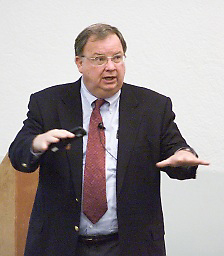 |
The Berkeley Lab budget for fiscal year 2002 will be flat largely — and that’s not necessarily a bad thing, according to Director Charles V. Shank.
“That’s a pretty good budget number,” he told an audience of auditorium and Internet-based listeners at a special briefing on Monday. “With all the pressures that the government is under, it’s something we can live with.”
He also noted that the budget total ($430 million), just a few million below last year’s final number, is likely to go up if the traditional add-ons come through as programs are supplemented during the year.
Shank said the Department of Energy’s Office of Science budget, which at $3.2 billion is almost 2.5 percent above that for FY 2001, includes $10 million for facilities and infrastructure, some of which he hopes will go toward decommissioning and demolition of the Bevatron accelerator complex. This would free up “the most beautiful space at the Laboratory,” he said, and allow it to be used for other things. Funding is needed to begin the process, though the full clean-up project will probably take a decade.
Also included in the budget, Shank said, is funding for initial designs for a new nanotechnology research facility at Berkeley Lab called the Molecular Foundry. If approved by the DOE and Congress, the building will be constructed adjacent to the Advanced Light Source.
The Director referred to remarks made recently by Secretary of Energy Spencer Abraham about a possible mission realignment in the DOE. Although it caused some consternation within the research community because of the absence of science as a referenced mission, Shank assured the audience that the Secretary has since reaffirmed the importance of science to departmental priorities.
“My feeling is as they [the administration] move forward, they will take a hard look at all programs and find that science is a significant piece,” he said. Noting that the country “is in for a struggle” in the coming years, Shank said he expected the laboratories to experience some of the impact of a falling economy. And he said the labs will be asked to assist the government with the expertise they bring in various disciplines as the war against terrorism continues.
But, he added, “I don’t expect draconian changes. We just need to be even more creative, more effective, and have more compelling ideas. The future depends upon our own energies and our own ability to advance programs.”
Shank pointed to three programs that were showcased this week in Washington as part of an exhibition of DOE science capabilities: Berkeley Lab’s air transport analysis for buildings, its work with neutron sources in detection devices, and the Joint Genome Institute’s rapid DNA sequencing of biological agents. All are potential contributors to the nation’s response to September 11.
Commenting on the Laboratory’s own efforts at responding to heightened security measures within the department, Shank said his hope is to disturb the work and openness of the Lab minimally while being responsible stewards of the facilities. For employees, this means carrying Lab identification at all times and enduring extra security checks at gates and on buses. For visitors, it means possessing visible, positive identification and proof of business need.
Don Bell, emergency services manager for the Lab, told everyone that the best way to ensure visitor access is to complete a simple web-based form before their arrival on site.
In a question session that followed, the Director reassured
scientists that international collaborations should not be affected by
new security measures, nor does he expect any additional restrictions
on foreign travel.
* * *
The video transmission of the Director’s briefing has been saved as a Video on Demand file. To view the program, start RealPlayer and enter address tsp://128.3.3.41:554/ budget.rm. The presentation begins approximately five minutes into the program. You may advance to the beginning of the talk by moving the slide bar at the top of the window to the right while monitoring the time into the transmission at the lower right side of the window. Stop when the time reaches 5:30. The transmission will begin.
By Lisa Gonzales
This year the Lab’s SHARES charitable giving campaign is giving special focus to the Lawrence Hall of Science, the Chabot Space & Science Center, and several September 11 recovery funds sponsored through Community Health Charities, the United Way, and the American Red Cross. Representatives from these organizations visited the Lab this month to talk about how they convert our contributions into assistance for others.
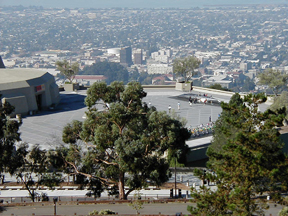 The Lawrence Hall of Science is one of the science education institutions that will benefit from this year's SHARES campaign. |
Michael Reynolds, the executive director of the Chabot Space & Science Center (CSSC), visited the Lab last week to discuss the events, programs and exhibits at this state-of-the-art science education center in the hills of Oakland. CSSC receives very little funding from the government for their $7.2 million operating budget, relying instead on support from volunteers, membership, and community support.
“Our mission is to inspire, inform, and engage,” said Reynolds. “The Lab is the community where the real support comes from because you want everyone to know how exciting science can be.”
Those who contribute $10 or more per month to the CSSC will receive a family pass for free general admission and parking, complimentary vouchers to the Planetarium and Tien MegaDome Theater, and other benefits — a $70 value. To learn more about CSSC see http://www.chabotspace.org/.
The Lawrence Hall of Science (LHS), another one of SHARES’ featured charitable organizations, is a resource center for preschool through high school science and mathematics education and a public science center with hands-on exhibits. Classes such as “Household Science” and “Fur, Feathers, and Scales” are offered, along with professional development programs for teachers and administrators.
“We look to individual contributions to fund scholarships for student programs,” says Barbara Ando, LHS’s associate director for public programs. “Many Lab employees send their kids to our classes, and our goal is to make this opportunity available to all children regardless of their families’ financial circumstances.” For more information, visit http://www.lhs.berkeley.edu/.
Those who wish to donate to September 11 recovery funds can do so through Community Health Charities, the United Way, and the American Red Cross.
Following the events of September 11, the American Red Cross has provided $111.3 million in direct assistance, helped approximately 25,000 families, and offered food, temporary shelter, counseling, and cash assistance to survivors, families of those lost, rescue and recovery workers, and others in need. They are now seeking donations for their Annual Disaster Giving Program, which helps to secure a reliable funding base for disaster relief services for individuals and families impacted by disaster anywhere in the country.
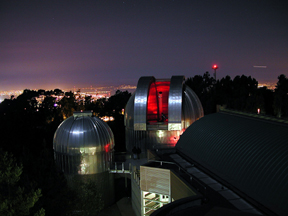 The Chabot Space & Science Center accommodates almost 60,000 visitors a year. Its facilities include a 243-seat planetarium, the Challenger Learning Center, public 8" and 20" refractor telescopes, and the Tien MegaDome Science Theater with a 70-foot dome-screen and the Bay Area's only 70mm, 8-perf projection system. Larger-than-life films have taken viewers aboard the Space Shuttle, along the ocean floor, and soaring over the pyramids of Giza and into the shadowy chambers of King Tutankhamun's tomb. Courtesy of Chabot Space & Science Center |
Through the United Way, employees can donate to the September 11th Fund (www. uwnyc.org/sep11), established by The New York Community Trust and United Way of New York City to meet the immediate and longer-term needs of victims, families and communities affected by the terrorist attacks. Since the first days of the attack, the Fund has been providing emergency grants to experienced disaster relief agencies directly serving immediate needs of victims and their families. Agencies are still actively engaged in providing cash assistance, legal counseling, grief therapy, job training and placement, and other services. For a current list of grants made by The September 11th Fund and to see how those agencies are using their funds, see http://www.uwnyc.org/sep11/list.html.
SHARES’ umbrella federation, Community Health Charities (http://www.healthcharities.org/), has many member charities that are also contributing to the efforts of emergency disaster relief. These include the American Lung Association of New York 9-11 Respiratory Assistance Fund (http://www.lungusa.org/), which has provided nebulizers and oxygen for New York rescue efforts, as well as the National Hospice and Palliative Care Organization (http://www.nhpco.org/) which called in all of its grief counselors nationally to assist families and individuals in both New York and Washington.
The Berkeley Lab SHARES campaign concludes Wednesday,
Nov. 21. All employees should have received a campaign packet at the end
of October that included a letter from Lab Director Charles Shank, information
about the charitable agencies, a pledge form and a pre-addressed envelope
for submitting donation materials. More information can be found on the
SHARES website at http://www.lbl.gov/shares/.
By John Bashor with Paul Preuss
At this week’s SC2001 supercomputing conference held in Denver, Colorado, visitors were likely to encounter a roaming robot named RAGE. Despite its fearsome moniker, RAGE is intended to be a convivial sort of gadget, built specifically for the purpose of extending the reach of the group-communication tool known as the Access Grid to people and events far from the Grid’s fixed “nodes.”
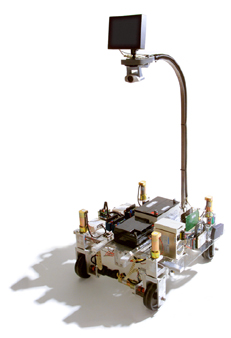 |
Although originally named IMAGINE, for Integrated Mobile Access Grid InterNet Entity, the Computing Sciences employees who built the beast in their spare time evidently thought an acronymic loss was worth a gain in conceptual clarity. They settled on RAGE, for Remote Access Grid Entity. Put together over a period of five months, RAGE combines the robot-building experience of NERSC’s John Shalf and Information Technologies and Services Division’s Zach Radding with software for collaborative systems developed over the years by NERSC’s Distributed Systems Department.
Made of off-the-shelf components and encased in a custom shell built by Radding in his garage on a recent weekend, RAGE is connected by wireless to a remote computer interface, where the operator can see through the robot’s small camera. The robot is also equipped with an LCD screen and speakers, which allows two-way communication between the operator and anyone the robot meets, wherever it roams.
RAGE debuted at the SC2001 conference, capturing both technical presentations and less formal human interactions in the exhibit hall, feeding the information into the Access Grid and thence to the world. The control connection is secure enough to discourage unwanted interference. Someday, this kind of technology may allow a robot to be a stand-in at technical conferences, allowing people to watch presentations and interact with presenters without the hassle and expense of traveling to distant meetings.
The Access Grid was initiated several years ago at Argonne National Laboratory and developed with the collaboration of numerous laboratories, universities and other institutions, including significant input from Berkeley Lab, including MBone multicast technology. The Access Grid uses multimedia displays and visualization environments to support large distributed meetings, collaborative work sessions, seminars, lectures, tutorials, and training exercises, emphasizing group-to-group communication.
RAGE was designed to take the Access Grid beyond the walls of its specially built, inherently immobile nodal facilities. Because RAGE has four-wheel drive and four-wheel steering, with remote operation by way of 802.11 wireless network technology, it can provide Access Grid interaction in many locations not equipped with a node. RAGE explored the SC2001 exhibit hall and attending technical and plenary sessions, providing remote participants with a physical (if nonanthropic) presence in the room and thus a more direct means of interacting with those attending in person.
Once it returns to Berkeley Lab, RAGE is expected to provide remote tours of the Oakland Scientific Facility.
The RAGE Team includes John Shalf, Zach Radding, Deb Agarwal, Keith Jackson, Marcia Perry, Martin Stoufer, Joshua Boverhof, Dan Gunter, Eve Edelson of the Environmental Energy Technologies Division, and Clayton Bagwell.
Photos of the team and the robot in various stages of
construction can be found at http://www-itg.lbl.gov/~deba/RAGE/. Specifications can be found at http://infinite-entropy.lbl.gov/IMAGINE/.
It may have taken a long time for his name to be submitted, but once in office presidential science advisor John Marburger quickly made his presence felt when he eliminated two of the four senior positions within the Office of Science and Technology Policy (OSTP) that he now heads. Eliminated were the advisory positions on national security and environmental matters. The two positions remaining are science chief and technology chief.
“I felt OSTP was too fragmented to be effective, and I wanted to have more direct control,” Marburger said in announcing the change.
Marburger has nominated Richard Russell, now OSTP chief of staff, to serve as technology chief. Russell worked for nearly seven years on
the House Science Committee, but unlike most of his predecessors, does not have an advanced scientific degree.
“This is not
an academic appointment, and dealing with academic aspects of technology
is only part of what we do,” said Marburger in defense of his nominee.
The long-range planning subgroup of the DOE/NSF High-Energy Physics Advisory Panel (HEPAP) said that building a new linear collider, preferably in the United States, should be the top priority for the nation’s high-energy physics agenda. The panel called on the federal government to make a strong bid to build a high-energy, high-luminosity, electron-positron linear collider. Projected costs would be about $5 billion to $7 billion, with as much as $2 billion of this coming from redirecting federal funds for current high-energy physics programs. An addition $1.5 billion to $2 billion would be sought from foreign sources.
Said Barry Barish, a physicist at Cal Tech and co-chair of the HEPAP subgroup, “This is a global sport now, and we can’t do anything without considering the international picture.”
Barish’s subgroup also recommended that HEPAP establish a panel that would play a key role in determining research priorities at the national labs and other research centers. Called the Particle Physics Project Prioritization Panel, this committee would evaluate particle-physics projects costing about $50 million to $500 million which, said the subgroup report, “make up a major part of the U.S. high-energy physics program.”—Lynn Yarris
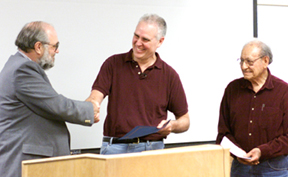 |
Rick Gough, head of the Ion Beam Technology group in the Accelerator and Fusion Research Division, congratulates John Staples of AFRD after handing him the J. Michael Nitschke Award for Technical Excellence on Nov. 2. The award was established by nuclear chemist Albert Ghiorso (right) in 1997 to honor individuals whose accomplishments make major scientific discoveries possible.
Staples was recognized for his contributions to accelerator physics. According to Gough, Staples played an especially important role in developing the Radio Frequency Quadrupole (RFQ) for the Spallation Neutron Source, a six-laboratory collaboration for which Berkeley Lab is designing the front end.
“Rick and I have worked together for about 30 years, and it was indeed a pleasure to have him present the award,” Staples says, “and of course even more of a pleasure to have been chosen by Al for it.”
The award is made through the East Bay Community Foundation with funds from the estate of the late Michael Nitschke, a Berkeley Lab nuclear scientist who died in 1995. Photo by Robert Couto
The Super-Kamiokande neutrino detector, the $100 million Japanese rival to the Sudbury Neutrino Observatory (SNO), has been retired from the research playing field for the foreseeable future. During a routine repair operation that required the draining and refilling of Super-K’s tank, which holds 3,000 tons of pure water, more than half of the detector’s 11,146 photomultiplier tubes shattered in an apparent chain reaction. Officials at the Super-K have no idea what triggered the accident, nor how long it will take for the facility to be repaired and put back on-line.
“We will rebuild the detector. There is no question,” said Yoji Totsuka, director of the director of the University of Tokyo’s Institute for Cosmic Ray Research (ICRR), which heads an international collaboration of 120 physicists from 23 institutions operating the Super-K detector.
Looking to develop a manufacturing technique for making computer chips that would operate six times faster than today’s most powerful microprocessors, DOE and a consortium of six computer companies have extended to March 2005 a 1997 CRADA (cooperative R&D agreement) scheduled to expire this coming March. The purpose of the CRADA is to develop extreme ultraviolet lithography technology.
Berkeley Lab is one of three national labs participating in this CRADA, along with Lawrence Livermore and Sandia. The participating computer companies are Advanced Micro Devices Inc., IBM Corp., Infineon Technologies, Intel Corp., Micron Technology Inc., and Motorola Inc. To date, some $250 million has been spent on the project, and the CRADA extension provides an additional $65 million.
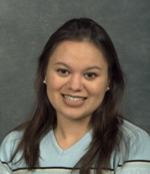 |
Maritza Alvarado, a student lab assistant in Life Sciences Division’s Department of Functional Imaging, has been awarded a National Institutes of Health fellowship entailing eight years of funding — all expenses plus a $20,000 year stipend — for an M.D./Ph.D. program. Only five such awards were given out nationwide.
Alvarado has been working under the mentorship of Anat Biegon on the development of novel fluorine-containing NMDA antagonists for brain imaging. The NMDA receptor has been implicated in neuronal death following stroke, brain injury, and neurodegenerative disorders such as Alzheimer’s, Parkinson’s and Huntington’s diseases.
By Lynn Yarris
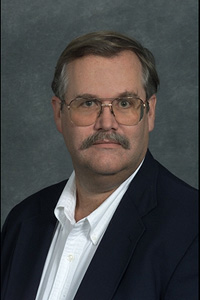 |
At a time when the threat of anthrax-laden letters has the entire nation on edge with anxiety, it was most fitting that Terry Hazen, who heads the Center for Biotechnology (CEB)in the Earth Sciences Division (ESD), provided a scientific perspective on anthrax and other pathogens in an ESD seminar entitled “Why do good bugs go bad?” The talk was held last Friday, Nov. 9, in the Building 50 auditorium.
“Widespread and indiscriminate use of antibiotics and climate change are much more likely to have long-term effects on pathogen ecology and human health than intentional releases of pathogens by terrorists,” Hazen said. However, he did caution that, “When you’re up to your ass in alligators it’s difficult to remember that your original plan wasn’t to drain the swamp.”
Hazen, who holds a Ph.D. in microbial ecology from Wake Forest University, is an award-winning researcher whose patents on bioremediation processes are used throughout the United States and Europe. He is also internationally known for his earlier research on indicators and pathogen survival in the environment, providing technical guidance for both the US EPA and the United Nations. He came to Berkeley Lab in 1998 after cutting his professional teeth at the University of Puerto Rico and the Savannah River Site, and has headed the CEB since 1999.
In his ESD seminar on Friday, he stressed that while current events have thrown a spotlight on the dangers posed by anthrax and other microbes, these dangers are not entirely new.
“Microbial life has been around for more than 3.7 billion years and accounts for approximately 60 percent of all the biomass on earth,” he said. “There may be as many as ten-to-the- seventh different species, capable of dividing once every 20 minutes and undergoing four simultaneous mutations in every gene in less than an hour.”
Microbes are not only abundant, they are superbly adaptable, able to exist under a broad expanse of environmental conditions, from extremely cold to extremely hot temperatures, from acidic to basic pH levels, or from near-vacuum to high-pressure. They can even survive exposures to more than 2 million rads of radiation.
“Microbes find it toasty in radioactive environments that would smoke every other living organism,” Hazen said.
On the whole, microbes do far more good than harm. For example, they cycle more carbon and nitrogen than all plant life combined. They are also nature’s premier recycling agents. As Hazen pointed out, “There is no compound known to science that microbes cannot degrade.”
So why do good bugs go bad? Essentially, it is the survival strategies pursued by various microbe populations that can succeed at our expense. For example, Bacillus anthracis, when faced with nutritional shortages, will go dormant inside a hardened cyst or endospore. In this metabolically inactive state, protected by the endospore, the anthrax bacteria can wait for more than 200 years and still be viable when it finds itself in a nutritionally rich environment, such as a human lung.
Bacillus anthracis produces two toxins that make it pathogenic to humans and distinguishes it from the ubiquitous but benign Bacillus cereus microbe. Humans can become infected either through an open wound in the skin or through inhalation, but it is the air-borne anthrax spores that are the biggest concern because these spores can remain in the air almost indefinitely once they are aloft. Hazen told his audience of military tests in the 1950s in which spores simulating anthrax were released about two miles off the coast of San Francisco.
“As many as 10,000 spores reached parts of the city and penetrated as far east as Berkeley on the clearest day. This is the number of spores humans have to inhale to become infected with the anthrax disease,” he said. “However, on typical weather days, no infectious doses were detected on the mainland.”
Hazen said there have been 237 cases of anthrax disease in humans in the United States between 1955 and 2000. He speculated that with regards to recent tests showing the presence of anthrax in various buildings in Washington and New York, the anthrax has probably been there for a long time, only “no one ever looked for it before.”
This would not be the first time that an airborne pathogen’s presence did not come to light until after its tragic consequences were felt. Legionella pneumophila, better known as Legionnaire’s Disease, was discovered following an outbreak at a 1976 American Legion convention in Philadelphia that resulted in 29 deaths and 200 hospitalizations. Hazen said it was subsequently learned that the bacteria is common in the environment and antibodies were found in human blood from epidemics dating back to the 1940s.
Waterborne epidemics have been even worse, Hazen said, citing a 1993 outbreak of Cryptosporidium parvum oocysts from cows in Milwaukee, Wisconsin, that resulted in more than 100 deaths, 4,400 hospitalizations, and more than 400,000 illnesses. Apparently, a slow sand filter did not remove the oocysts from the city water supply.
Even without the machinations of bioterrorists or equipment failure, Hazen said there are other factors, such as climate change and exposure to ultraviolet radiation from the sun that can exacerbate the threat from microbes.
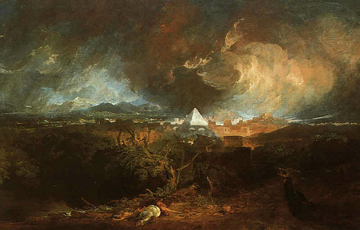 The biblical Fifth Plague of Egypt, depicted in J.M.W. Turner’s 1800 painting, took place in the second millennium B.C.E. Hazen said it “described an anthrax epizootic.” |
“Warming or cooling trends can change the distribution of pathogens and disease vectors,” he said, “and increased exposure to ultraviolet rays can increase mutation rates with unpredictable effects on the ecosystem as a whole and on pathogen development specifically.”
Still, it is the idea of biological warfare that unnerves many — and even that, Hazen says, is not exactly a new idea. Hannibal filled clay pots with serpents and hurled them at enemy ships; the Tartars tossed plague-ridden corpses over the city walls of Kaffa; and Pizarro gave smallpox-infected clothing to the Incas.
“The fifth plague of Egypt, which took place around 1491 B.C., described an anthrax epizootic,” Hazen said.
Asked whether he personally changed any of his daily activities as a result of the recent outbreak of anthrax, Hazen answered no.
“There’s a small probability of opening an envelop with
anthrax,” he said, “and if you do, the symptoms are recognizable and treatable.”
By Paul Preuss
|
|
For three days in mid-October, over 350 scientists and other fascinated participants flocked to the annual ALS Users’ Meeting to hear about the year’s scientific advances, see the ALS’s new superconducting bend magnets (“superbends”) for themselves, and exchange ideas for future directions in synchrotron light sources.
In his welcoming remarks on Oct. 15, Berkeley Lab Director Charles Shank forecast an era of new science to be ushered in by the ability of the superbends to achieve energies extending into the hard x-ray range. Among the dignitaries in attendance was Patricia Dehmer, DOE’s associate director for Basic Energy Sciences, who underscored the dramatic turnaround in the fortunes of the ALS in just four years (since the publication of the so-called Birgenau Report in November 1997).
Dehmer suggested that the new challenge facing the ALS is to maintain its acknowledged position of leadership. Much of the subsequent discussion at the meeting focused on how the ALS could best focus on newly emerging fields of science while becoming more accessible to its worldwide community of users.
The latter topic is dear to the heart of Yves Petroff, former director general of the European Synchrotron Radiation Facility, currently on sabbatical and serving as senior advisor to ALS director Daniel Chemla. Among other improvements, Petroff would like to see more and better living accommodations — parking spaces included — made available to users. He and ALS science deputy Neville Smith have also recommended new resources and procedures to make working at the ALS easier for scientists who are not synchrotron initiates.
Following the plenary session, two days were devoted to seven different workshops on topics ranging from advanced detectors to molecular environmental science to high-pressure studies and more. The new superbends were hardly the only factor fueling interest in the future. The excitement generated by the renaissance of the ALS could be found, for example, in one particularly popular workshop that concentrated on the opposite end of the energy spectrum: the middle and far infrared. (See sidebar on IR workshop.)
Prizes at party-time
This year the traditional Users’ Meeting banquet was held outdoors on the patio of the ALS, its unparalleled view of San Francisco Bay unfortunately hampered by fog. The hearty buffet dinner kept spirits up, and a round of prizes presented by outgoing Users’ Executive Committee chair Harald Ade of North Carolina State University capped the event. Prizes included the David Shirley Award for science at the ALS to Gary Mitchell and Ed Rightor; the Halbach Award for instrumentation to David Robin and his colleagues; the Renner Users’ Service Award to Erike Arenholz and Ken Barat; and the award for best student posters to Hendrik Ohldag and Christoph Bostedt.
For more about the 2001 ALS Users’ Meeting, visit http://www.als.lbl gov/als/usermtg.
On the first day of the IR workshop, organized by Michael Martin and Wayne McKinney of ALS infrared beamline 1.4, attention focused on current research successes. On day two, discussion turned to ideas for a brand new facility: a new infrared ring to be constructed under the ALS dome.
“The current IR beamline is great for near-infrared microscopy and spectroscopy,” says Martin, “but because the ALS was originally built for extreme ultraviolet and soft-x-ray light, it can’t do much in the far infrared.” For example, longer wavelengths are often eliminated by the geometry of existing beam ports.
A combination of factors suggests that a uniquely capable infrared facility could be built using the shielding structure of the existing booster ring as a foundation. The booster ring shielding is not constructed from blocks of concrete but was continuously poured as a single structure, eliminating many vibration problems. Electrons would be injected into the dedicated IR ring from the existing linac at long intervals, with no overlap or interference with the needs of the main ring.
The IR ring would use extremely short bunches of electrons. Synchrotron radiation produced by electron bunches shorter than the wavelength of the radiation itself — in this case, long-wavelength infrared — is coherent, increasing brightness by many orders of magnitude.
Extremely short pulses would open new research possibilities, such as observing rapid chemical changes in living cells in real time. Another area of science that would benefit greatly from a bright far-infrared source and its vast increase in signal over existing lab methods include studies of high-temperature superconductivity, colossal magnetoresistance, and other aspects of the electronic structure of strongly correlated materials.
Studies of the feasibility of a dedicated IR ring at the ALS, with 36 ports of which a dozen would be in use at any time, are currently supported by Berkeley Lab’s Laboratory Directed Research and Development program. Integrating the new ring with existing facilities promises to make it remarkably economical.
The IR-ring scheme is just one of numerous opportunities for keeping the ALS in the forefront of synchrotron radiation science.
For more about infrared studies at the ALS visit http://infrared.als.lbl.gov/.
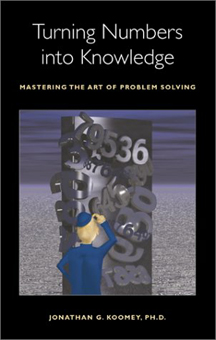 |
In his role as leader of the End-Use Forecasting Group in the Environmental Energy Technologies Division’s Energy Analysis Department, Jonathan Koomey is professionally concerned with using numbers from many different sources to gain knowledge about where markets for energy-efficient technologies may be headed. It’s an approach called quantitative problem solving.
“Although the technical aspects of this process are taught at many universities, the art of problem solving is rarely discussed and even more rarely written down,” Koomey notes in the preface to his latest book, Turning Numbers into Knowledge: Mastering the Art of Problem Solving. His goal is to amend that lack, helping the reader “to become a first-rate analyst in your chosen field.”
“Your chosen field” covers a lot of ground, and while Turning Numbers into Knowledge delivers on Koomey’s promise, much of the pleasure of reading it comes from his eccentric definition of both his topic and his audience. Not a textbook — or not just a textbook — Turning Numbers into Knowledge is aimed at students and professors alike; at problem solvers in business, government and research; at middle managers and potential investors; and even at journalists.
With a chapters such as “Beginner’s Mind,” “Question Authority” and “Reflect,” one might think Koomey’s book could have been named Zen and the Art of Statistical Analysis. But it is also full of technical advice, in chapters like “Let Tables and Graphs Do the Work,” “Use the Internet,” and many more.
In fact, Koomey has organized his topics thoughtfully, beginning with considerations of why anyone, professional or amateur, would undertake quantitative analysis. His bottom-line answer is that it helps us manage a runaway information explosion, which otherwise can lead either to paralysis through overload or to the opposite — a refusal to learn anything new. He then moves on to the mental preparation needed for problem solving, consideration of common pitfalls, critical thinking, and finally to nitty-gritty techniques.
In the first chapter, “Beginner’s Mind,” Koomey reminds the reader that “experience is a two-edged sword. It eliminates unnecessary detail,” but it can also “lead you astray when a new problem is sufficiently outside your experience.” What’s needed, he says, is a combination of curiosity — the nonjudgmental observation of the beginner — with the experience of a senior analyst.
He makes his point with Bruce Lee’s amusing parable of the Zen master and the Western university professor who came to inquire about Zen but never stopped talking about what he already knew. During a pause in the monologue, the master suggested tea. He poured his visitor’s cup full and kept on pouring and pouring until finally the professor protested: “No more will go in!” Noting that the professor’s mind was like his teacup, the master asked “How can I show you Zen unless you empty your cup?”
Later, in the chapter “Question Authority,” Koomey allows that sometimes following authority is essential — in military maneuvers, for example — but that most life situations aren’t like that. Appeals to anonymous authority are immediately suspect; so are expert pronouncements by experts in an unrelated field, or those with a vested interest in the outcome. Koomey cites the “expert” testimony of researchers funded by tobacco companies who found no evidence that smoking had adverse health effects. He warns that while information on the internet is particularly susceptible to a lack of institutional validity, “any source can propagate nonsense.”
In an exercise from a subsequent chapter, “How guesses become facts,” Koomey suggests that the reader “Find an official statistic that sounds plausible and explore its origins. Do you still find it plausible after you’ve investigated?” It’s an exercise Koomey himself has undertaken more than once, notably with the 1998 claim that the internet was consuming eight percent of total U.S. electricity production and was well on its way to consuming half. Koomey discovered that the numbers were based on bad measurements, bad assumptions, and outright guesses — none of which prevented them from becoming enshrined as fact before Koomey’s EETD team did their best to set things straight. (See http://www.lbl.gov/Science-Articles/Archive/net-energy-studies.html)
In summing up the lessons of Turning Numbers into Knowledge,
Koomey lists a dozen points to remember, among them “Don’t be intimidated,”
“Get organized,” “Document, document, document,” and “Remember that others
don’t care as much about your work as you do” — an invitation to know
and persuade one’s audience. It’s sound advice, cheerfully and colorfully
delivered by a man who knows what he’s talking about, and of value to
all sorts of readers — whether or not they intend to ever crunch a single
number. — Paul Preuss
* * *
Turning Numbers into Knowledge: Mastering the Art
of Problem Solving, by Jonathan G. Koomey, with illustrations by Tom Chen,
published by Analytics Press, 221 pages hardcover, $34.95.
Open Enrollment Informational Meeting Today
The Lab’s Benefits Department is holding an all-employee Open Enrollment informational meeting today from 10 to 11:30 a.m. in the Building 50 auditorium. Featured will be an overview of Open Enrollment changes and updates on the retirement plan tax laws (EGTRRA) that will go into effect on Jan. 1. Employees are invited to ask questions about health care plans and the Open Enrollment process. Refreshments will be served.
The Open Enrollment period continues through the end
of the month, with changes effective Jan. 1, 2002. Detailed information,
including side-by-side comparisons of plan benefits, is available on the
HR/Benefits Open Enrollment website at http://www.ucop.edu/bencom/oe.
Center for Science and Engineering Education (CSEE)
Last week the Center for Science and Engineering Education (CSEE) held their Education Outreach meeting to kick off the Lab efforts for the new school year while acknowledging the hard work of mentors during this past year. The meeting began with Director Charles Shank recognizing outstanding mentors during the FY2001 programs.
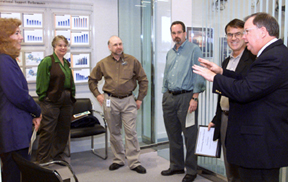 |
“Mentoring is an important part of what we do here,” said Shank, who has mentored many students that he often encounters during his travels to research facilities throughout the country. “I can’t overestimate the impact we can have on a young person just beginning to consider a future in the sciences.”
Those named Outstanding Mentors for 2001 are Ken Barat
of Environment, Health & Safety; Regine Goth-Goldstein, Lara Gundel
and David Lorenzetti of Environmental Energy Technologies; Mike Martin
of the Advanced Light Source; Rick Norman of Nuclear Science; and Dale
Perry and Will Stringfellow of Earth Sciences. They were chosen based
upon the comments of the students and a long history of commitment to
education outreach. Photo by Robert Couto
Course on Unix Security
To help Unix users achieve security in their systems,
the LBNL Computer Protection Program is sponsoring a full-day course on
Unix security on Wednesday, Dec. 5. The event will be held from 9 a.m.
to 5 p.m. in the Building 66 auditorium and will cover the following topics:
· Major types of security-related vulnerabilities
· Physical security
· File protection
· System and network protection
· Account security
· Logging
· Special security needs for different flavors of Unix
· Useful tools (ssh, sudo, tcpdump, Tripwire, Crack, Fix-Modes, etc.)
The instructors will be Jim Mellander and Gene Schultz.
There is no charge for attending, but preregistration is required. To
register send email to cp-seminar@lbl.gov and eeschultz@lbl.gov.
Oakland Ballet Nutcracker Tickets
The Employees’ Arts Council (EAC) is offering discounted
tickets for the 6 p.m. performance of Oakland Ballet’s Nutcracker on Saturday,
Dec. 22. The ballet is performed at the art deco Paramount Theatre in
Oakland and accompanied by the Oakland East Bay Symphony. Orchestra tickets
are $34 for adults (regularly $45), and $27 for children 12 and under.
Tickets must be ordered and paid for no later than Nov. 21. No babies
in arms admitted. To purchase tickets, contact Mary Clary at X4940 or
MMClary@lbl.gov.
Travel Safety Tips
Because of the recent heightened awareness about travel
safety, the Travel Office has posted a list of travel safety tips on its
website at http://www.lbl.gov/Workplace/CFO-Travel/travel_safety_tips.html.
Most are common sense guidelines, although some refer to specific travel
situations. Some of these tips include:
General
International Travel
Publication Reminder
Because of Currents’ holiday schedule adjustment, the next issue will be published on Dec. 7. Please keep this in mind when planning your submissions for Calendar (deadline Dec. 2) or Flea Market items (deadline Nov. 29).
General Interest
OPEN ENROLLMENT INFORMATION MEETING
10 a.m. – 1:30 p.m., Bldg. 50 auditorium
THE BIG GAME: CAL VS. STANFORD
12:30 p.m., Stanford Stadium
END OF SHARES CAMPAIGN
THANKSGIVING
HOLIDAY
HAPPY HOLIDAY
END OF OPEN ENROLLMENT PERIOD
Send us your announcements
Announcements for the General Calendar and Bulletin Board
page may be sent to MSFriedlander@lbl.gov. Seminar & Lectures items
may be mailed to currents_ calendar@lbl.gov. You may also fax items to
X6641 or mail them to Bldg. 65B. The deadline for the Dec. 7
issue is 5 p.m. Monday, Dec. 2.
DEPARTMENT OF PHYSICS COLLOQUIUM
Solar Neutrinos: An Overview
Speaker: John Bahcall, Institute for Advanced Study
4:30 p.m., 1 Le Conte Hall
ENVIRONMENTAL ENERGY TECHNOLOGIES DIVISION SEMINAR
NSF Funding Opportunities for LBNL-Mentored Research
Speaker: Roland J. Otto, Center for Science and Engineering Education
Noon, Bldg. 90, Room 3148
DEPARTMENT OF PHYSICS COLLOQUIUM
Science with Synchrotron Radiation
Speaker: Yves Petroff, Advanced Light Source
4:30 p.m., 1 Le Conte Hall
CENTER FOR BEAM PHYSICS SEMINAR SERIES
Experimental Science at the Extremes: Laboratory Astrophysics on High
Energy Density Facilities
Speaker: Bruce Remington, Lawrence Livermore National Laboratory
2 p.m., Bldg. 71, Albert Ghiorso Conference Room
SURFACE SCIENCE AND CATALYSIS SEMINAR
Dynamics of Photo- and Thermal-Induced Reactions on Silver Surfaces
Speaker: Mike White, Brookhaven National Laboratory
1:30 p.m., Bldg. 62, Room 203
ENVIRONMENTAL ENERGY TECHNOLOGIES DIVISION SEMINAR
Mercury Transport and Transformation in the Wider Idrija Mercury Mine
Region, Slovenia
Speaker: Milena Horvat, Jozef Stefan Institute, Ljubljana, Slovenia
Noon, Bldg. 90, Room 3148
DEPARTMENT OF PHYSICS COLLOQUIUM
Using Plasma for Compressing Very High Power Laser Pulses
Speaker: Nathaniel J. Fisch, Princeton University
4:30 p.m., 1 Le Conte Hall
LIFE SCIENCES DIVISION SEMINAR
Identification of Pathways that Suppress Genome Instability
Speaker: Richard Kolodner, Ludwig Institute for Cancer Research, UCSD
Noon, Bldg. 50 auditorium
SURFACE SCIENCE AND CATALYSIS SEMINAR
Surface Science with Nanoparticles in a Carrier Gas
Speaker: Hans Siegmann, SLAC
1:30 p.m., Bldg. 66 auditorium
CENTER FOR BEAM PHYSICS SEMINAR SERIES
RHIC Operation in 2001
Speaker: Wolfram Fischer, Brookhaven National Laboratory
10:30 a.m., Bldg. 71, Albert Ghiorso Conference Room
|
Date |
Course |
|
Time |
Building |
|
11/16 |
EHS 275 |
Confined Space Hazards |
9:00 – 11:00 |
51-201 |
|
11/16 |
EHS 274 |
Confined Space Hazards-Retraining |
11:00 – 12:00 |
51-201 |
|
11/16 |
EHS 330 |
Leads Hazards Awareness |
2:00 – 3:00 |
51-201 |
|
11/20 |
EHS 604 |
Hazardous Waste Generator |
9:30 – 11:00 |
51-201 |
|
11/20 |
EHS 622 |
Radioactive & Mixed Waste Generator |
11:00 – 12:00 |
51-201 |
|
11/20 |
EHS 735/ 738/739 |
Biosafety/Bloodborne Pathogen |
1:30 – 2:45 |
51-201 |
|
11/21 |
EHS 530 |
Fire Extinguisher |
10:00 – 11:30 |
48-109 |
|
11/21 |
EHS 210 |
Hoist |
10:30 – 12:00 |
51-201 |
|
11/26 |
EHS 62 |
MoveSMART |
8:30 – 11:30 |
51-201 |
|
11/26 |
EHS 62 |
MoveSMART |
1:00 – 4:00 |
51-201 |
|
11/27 |
EHS 62 |
MoveSMART |
8:30 – 11:30 |
51-201 |
|
11/27 |
EHS 62 |
MoveSMART |
1:00 – 4:00 |
51-201 |
|
11/28 |
EHS 62 |
MoveSMART |
8:30 – 11:30 |
51-201 |
|
11/28 |
EHS 62 |
MoveSMART |
1:00 – 4:00 |
51-201 |
|
11/29 |
EHS 60 |
Ergonomics for Computer Users |
2:00 – 3:30 |
51-201 |
|
11/29 |
EHS 400 |
Radiation Protection-Fundamentals |
9:00 – 12:00 |
51-201 |
‘95 FORD ESCORT Wagon LX, red, 63K mi, at, ac, 2 airbags, cd/radio, good cond, $5,000, Liv, X5119
‘92 SATURN SL2 sedan 4 dr, 4 cyl 1.9 L, 5 spd, 120K mi, ac, moonrf, all pwr, cruise, dealer maint, exc cond, $2,900 (below blue book), Raimond, X2296, 558-9351
‘86 MAZDA 323, brn, 85K mi, pwr steer, 4 dr, am/fm/cd, $2,000, Karla or Sabino, X4110, 704-4096
‘85 HONDA CIVIC 2 dr hatch, tan w/ black trim, 121K mi, 38 mpg, new tires, body a bit worn but mech sound, reliable, great commute car, $1,000/ bo, Diane, X5839, 658-9690
‘71 VW BEETLE, orange, dents, needs front axle beam replaced, $500, Jason, X7562, (415) 722-3486
BERKELEY HILLS, house avail for 7 month rental for visiting faculty or grad student, 3 bdrm/ 2 bth, furn, 3 bridge view, attached garage, fireplace, great yard, in Berkeley hills, near bus, minutes from Lab & shops, avail 1/15 – 8/15/02 (time neg), no smoking/pets, $1,950/mo incl water & biweekly housekeeper, Bill/ Ellen, X4890, 528-0553, wlcarroll@lbl.gov, ebgold@ucdavis.edu
El CERRITO, room avail in 2 bdrm/1.5 bth apt, avail for 5-6 months starting 1/1, furn or unfurn, balcony, d/w, covered parking, coin laundry in bldg, walk to pub trans & shops, no smoking/ pets, $610+util, Alysia, X2467, admarino@socrates.berkeley.edu
KENSINGTON, 2 rooms avail in 5 bdrm house, semi-cooperative, almost vegetarian, non-smoking, relaxed, friendly lge kitchen, view of bay, garden w/ fruit trees, w/d, dw, patio, hot tub, share w/ 5 others (grad students & scientists), 26-34 yrs old, no pets, no TV in common areas, 1 rm avail 12/1 (master w/ own bth) for $475, other rm avail Jan or Feb (in cottage w/ own bath for $480), steve@idiom.com, 524-2668
2 SWAN CHAIRS, new, turn-of-the-century antique reproduction, mahogany wood, $900, Mary, X7530
BABY CRIB, Jenny Lind style, like new, hardwood, natural color, $75, Dan or Judy, 799-0818
COUCH, 7' long, floral/vine pattern, very soft, can be used as a bed, 2 tears in fabric, $60; comfortable recliner, $50; glass/bamboo coffee table, $10; 2 drawer white metal filing cabinet, $15; small desk, $10; fax machine, $15, Jason, X7562, (415) 722-3486
FISHER CROWN X-Country skis, 188 cm w/ Salomon bindings, poles, women's Salomon boots size 7-1/2, top quality, hardly used, all for $140, Cami, X8625, (925) 736-5790
GOLF CLUB, taylor made titanium burner bubble driver 9.5 deg, $89; Hart F17 skis w/ salomon bindings 198cm, $59, Brian, X4526
LUTHER VANDROSS ticket for 11/20 at Paramount Theater in Oakland, orchestra seating, $75, Gina, X4311, 306-8784
WOOD DESK w/ 6 drawers, 60"x35"x33", recessed glass top, $125; Nordic Track Walkfit treadmill, $75, Steve, X6228
CAR AND LAPTOP COMPUTER donation for the Flying Samaritans, a group of volunteer physicians, nurses, dentists and others who run the Alma Luminosa clinic which provides free medical and dental care in Baja California, Mexico. The clinic needs (1) a car, van or pickup truck to transport clinic staff and patients (need not pass smog check – just as long as the klunker runs) and (2) a laptop to track patient medical histories; all donations are tax deductible, Drew Kemp, X5789, 524-7165 eve
TV CONSOLE w/ out the TV, 43.5"w x 33.5"h x 19"d, can hold 3 VCRs or DVDs, up to 20" TV, combo solid wood (walnut), veneers and plywood, weighs approx 200 lbs, you pick up, Brian, X4677
FOUND: expensive ski jacket on walk down the hill to UCB on Cyclotron Rd, David or Victoria, 236-9383
Ads are accepted only from LBNL employees, retirees, and onsite DOE personnel. Only items of your own personal property may be offered for sale.
Submissions must include name, affiliation, extension, and home phone number. Ads must be submitted in writing via e-mail (fleamarket@lbl.gov), fax (X6641), or delivered/ mailed to Bldg. 65B.
Ads run one issue only unless resubmitted, and are repeated only as space permits. They may not be retracted once submitted for publication.
The deadline for the Dec. 7 16 issue is Thursday, Nov. 29.